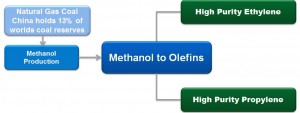Methanol to Olefins continues to be a hot topic at the International Zeolite Conferences. IZC18 was in June in Rio De Janiero this year. There were reports on improving the catalyst lifetime, for example, by reducing the size of the crystal or by using a Phosphonium co-SDA to tune the acidity and the textural properties of the catalyst. Also the olefin distribution is getting a fresh look.
For those of you who were unable to attend or may have missed these sessions, we have selected a few talks related to Methanol to Olefins, summarized them and by clicking on the titles you can download the associated abstracts:
- Oral Presentation: Nanocrystalline SSZ-39 zeolite as efficient catalyst for the MTO process (Manuel Moliner from ITQ presenting)
- catalyst is 50 nm wide and was made using the SDA tetraethyl phosphonium OH in a low water (H2O/Si = 5) recipe
- catalyst lifetime (before decoking was required) was improved 2x compared to 500 nm SSZ-39 made using ‘normal’ high water recipe
- propylene and ethylene yields were the same as 500 nm SSZ-39
- next is Oral Presentation: Selective Formation of propylene in dimethyl ether to olefin reaction over modified MCM-68 zeolite
- MCM-68 is a good DMTO catalyst compared to ZSM-5, with less aromatics formation and longer lifetime
- It was modified by immersion in aqueous ammonium hydrogen phosphate solution, which adds nonframework P atoms and quenches the Bronsted acid sites
- DMTO catalysis of modified MCM-68 produced no aromatics, very little ethylene and 50/23 ratio of propylene to butylene (which is easily converted to propylene, which would raise the yield to 83%)
- last is Plenary Session: Advanced Zeolites with Heteroatom Site Distribution in the Framework Controlled (Prof Takashi Tatsumi presenting)
- CIT-1 has large pores (10 and 12 membered rings) which as an MTO catalyst favors propylene and butylene over ethylene and little aromatics if Si/Al ratio > 100
- the Al atom distribution was controlled by variations in the amount of stirring
- synthesis under static conditions (i.e., no stirring) puts the Al atoms primarily at T4 sites, which makes it least prone to coking (and better than ZSM-5)
Would you like to discuss this Methanol to Olefins further…then Ask an Expert.
SACHEM provides our ZeoGen™ structured directing agents products and services for zeolite synthesis.

